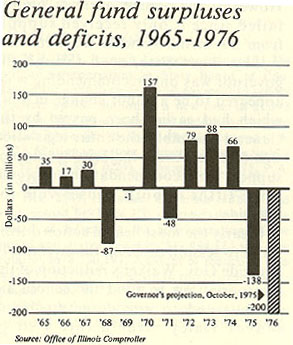The state of the State
All eyes focus on state's available balance
"AVAILABLE BALANCE" in the
state's general fund — what does the
figure mean to you? If you do business
with the state, are the recipient of a state
grant (such as public aid), or are a state
employee, it is an important figure. This
is especially the case when, as now, the
state is spending more than it is taking in
and the available balance in the general
fund has to be watched carefully to
safeguard against drawing it down to zero.
(The "general fund" in this discussion
is a composite of three funds— general
revenue, common school, and federal
revenue sharing — which account for
two-thirds of state spending.)
"The available . - . balance in the
General Fund is the amount of money
left after expenditures and revenues
have been tallied, like an individual's
checkbook balance," says State
Comptroller George W. Lindberg in The
Dynamics of Illinois State Finance: A
Fiscal Barometer, a 10-page booklet
prepared for a legislative seminar last
fall. "It is the single most important
indicator of the fiscal health of the
state."
Spending exceeds income
For example, the state began October
1975 with a balance of $39 million. Cash
receipts, primarily from taxes, came to
$315 million. Transfers from other
funds added up to $28 million. Federal
aid totaled $95 million. Total receipts:
$438 million. General fund spending
totaled $404 million (including public
aid, $158 million; school aid, $112
million; and state operations, $98
million). Transfers out to other funds
added up to $24 million. Total spending:
$428 million - $10 million less than
income. The closing balance for
October was $49 million (source:
"Comptroller's Monthly Fiscal Report" for
October 1975 released November 18).
Looking into the future is a chancy
business, but the comptroller is able to
project trends which take into account
official forecasts of revenues and what is
likely in the way of spending (based on
appropriations). Projections which he
presented at the seminar for legislators
last fall undoubtedly influenced several
to vote against overrides of the
education appropriation vetoes. These
projections took into consideration
$100 million additional which it is now
agreed will be needed to meet public aid
costs during fiscal 1976 if present
economic trends (and joblessness)
continue. The projections indicated that
the general fund balance would stay
around $40 million until March and
then rise to $100 million in June
(because of seasonal increases in tax
revenues).
Zero balance possible
But if the legislature had increased
appropriations last fall by another $ 100
million — by overriding vetoes on
education appropriations — the projections
showed the balance would drop
to zero in March. If this were to happen,
there would be delays in meeting state
payrolls, in paying the state's bills, and
perhaps in paying public aid grants. As a
matter of fact, the comptroller's November
18 release asserted that "the
Governor's agencies have begun a
slowdown in paying those who do
business with the state. Those affected
are doctors, hospitals . . . and other
commercial enterprises." (A spokesman
for the Bureau of the Budget under the
governor denied a "slowdown"
was occurring at the operating agency level.
Centrally, however, the payment of bills
was being managed to avoid a cash
shortage, he said.)
General fund surpluses
and deficits, 1965-1976

|
"Such a slowdown, if it continues, will
have the effect of shifting the cash flow
problems of the state to the private
sector, thereby allowing the state to
partially abandon its fiscal responsibility,
" Lindberg said. "That's bad news
for businessmen."
"To keep the state from becoming a
'dead beat' on paying its bills, we have to
face reality. Very soon we must either
cut spending or find new income."
Penalty for unpaid bills
If payment of bills is put off too long,
it could also cost the state money. House
Bill 221 (Londrigan, D., Springfield)
requires the state to pay a penalty of 1
per cent per month on bills unpaid after
90 days. The bill was vetoed by Gov.
Dan Walker, but passed both houses over his veto.
The state could borrow. The Constitution
permits borrowing up to 5 per
cent of appropriations in anticipation of
revenues and up to 15 per cent of
appropriations to meet deficits "caused
by emergencies or failure of revenue"
(Art. IX, sec. 9). But no enabling
legislation for such borrowing is on the
books. Internal borrowing—switching
from an earmarked fund to a general
fund — was tried during the Kerner
administration, but this procedure
seems of limited usefulness; amounts in
earmarked funds have already been
committed or appropriated.
|
Tax increase in wind?
The chart shows the history of surpluses
and deficits in the general funds
since 1965. The large deficit shown for
1968 occurred prior to the adoption of
the state income tax which brought in a
big surplus in 1970. Do the large deficits
for 1975 and those projected for 1976
presage a tax increase?/ W.L.D.
February 1976/Illinois Issues/23
